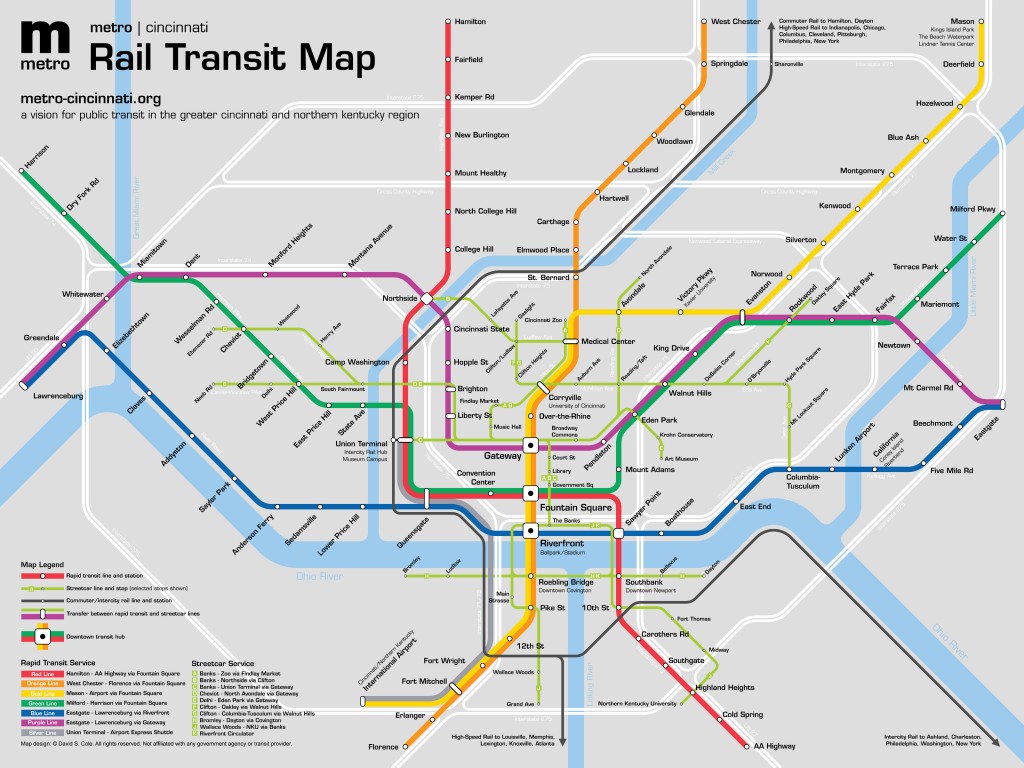Metro-Cincinnati.org began in 2009 as an academic design project to develop an architectural master plan for a regional rapid transit system for the Greater Cincinnati and Northern Kentucky metropolitan area. Although periodic efforts have been made to introduce rail transit to the region, including the partial construction of a subway line in the 1920’s and the current efforts to re-introduce streetcar service to the downtown core, Greater Cincinnati remains one of the largest US urban areas without any form of rail-based public transit. This proposal is loosely based upon the 2002 Metro Moves light rail initiative developed by the Southwest Ohio Regional Transit Authority and the 2030 Regional Transportation Plan unanimously adopted in 2008 by the OKI Regional Council of Governments.
Issues regarding capital and operational funding, public transit policy, ridership projections, civil and structural engineering, and political feasibility were not included within the scope of the design project itself. However, these issues are touched upon in the background research and in the author’s commentary.
Since the conclusion of the academic aspect of the project in the spring of 2010, the focus of this site and its associated social media outlets have evolved. Aspects of the transit master plan have been periodically improved and clarified, while the blog portion of the site has become a platform for education, commentary, and advocacy regarding the future of public transit in Cincinnati and beyond.
Your comments, questions, and feedback are always appreciated.
(See the original Project Proposal and Project Outline for additional information about the academic portion of this project.)
Note that this project and this website are in no way affiliated with any transit agency or provider, nor with any other governmental, commercial, or educational entity. The opinions expressed here are strictly those of the author.
All original text and images on this site are under copyright protection, and may not be reproduced without the author’s express written consent. Text and images from outside sources remain the intellectual property of their respective authors.
The primary focus of the project concerns the physical design of a hypothetical transit system, with a particular emphasis on the following three aspects:
Routes, Transit Modes, and Station Locations
The 2002 Metro Moves plan envisioned a three-tier system comprised of streetcars, light rail, and commuter rail. Several of the proposed light rail corridors incorporate abandoned railroad rights-of-way and run on surface streets in the central business district. While this provided a cost-effective way to introduce rail transit to Cincinnati, it had a number of shortcomings that limited the system’s future capacity and public appeal. Using the OKI plan as a starting point, this project proposes a modified regional plan that better serves the long-term transit needs of the public.
Station Typologies
This project identifies typical transit station typologies (subway, elevated, surface, etc.) and establishes architectural design parameters to create a framework by which the design of these facilities can be further developed in the future.
Downtown Transit Hub
Finally, this project proposes a schematic design for the primary downtown transit hub, located at the site of the existing below-grade Fountain Square parking garage, which will provide the primary transfer point between most of the proposed transit lines.
About the Author
In his professional experience dating back more than a decade, David has been responsible for daily design and production on a wide variety of project types in a diverse range of settings, ranging from small residential renovation projects in historic neighborhoods to multimillion-dollar civic, institutional, and corporate projects in major cities across the country. His experience includes tenures at a variety of venerable architecture firms in Chicago, New York, and Los Angeles, including three laureates of the national AIA Firm Award.
David began his formal architectural studies at the University of Illinois at Chicago, completed his Bachelor of Arts degree at DePaul University, and earned his professional Master of Architecture degree at the University of Cincinnati’s College of Design, Architecture, Art, and Planning, which is consistently ranked as one of the world’s top design schools.
When not involved with professional practice, David enjoys reading about history and geography, being involved in the community, listening to electronic music, sampling craft cocktails at his favorite tiki bars, and exploring new places from the side streets of London to the mountains of the Pacific Northwest.
David is a registered architect in the states of Ohio and Washington, a member of the American Institute of Architects, and holds certification from the National Council of Architectural Registration Boards.
More information:Â DavidColeAIA.com
Acknowledgements
Special thanks to:
My academic advisor Mechthild Hart at DePaul University and my professional advisor Jonathan Liffgens for their encouragement and feedback during the course of this project.
Jake Mecklenborg for his extensive knowledge of Cincinnati’s transit history, tireless advocacy for rail transit in Cincinnati, and for granting permission to use his photos here.
Ronny Salerno and David Pirmann for granting permission to use their photographs.
Pete Vesic at the Illinois Railway Museum. Rest in peace.
Brad Thomas, Casey Coston, Randy Simes, Nick Sweeney, John Schneider, and all others who helped defeat Issue 9 and who continue to advocate for passenger rail transit in Cincinnati.
The city of Cincinnati for welcoming me back home with open arms whenever I’ve shown up on the city’s doorstep.


